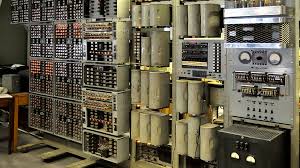I recently bought a copy of Physics of the Future by Michio Kaku and I discovered Moore’s Law. Simply stated it is that computer power doubles about every eighteen months to two years. It’s not a law of physics, just an observation from history. Kaku gives a neat little summary of development so far:
 |
| Vacuum computer Harwell Dektron |
It takes me back to my early working life in the 1970s, when I learned to read punched cards and paper tape on sight, and helped develop the first interactive screen connection for the Bank of England. This made it possible for a customer to be given their bank balance immediately instead of waiting for the overnight computer run!
Kaku also gives some amazing examples of how powerful computer chips have become.
Have you ever stopped to think about the power of the computer devices you take for granted and use so casually?
Interestingly, when I Googled Moore’s Law I found an article called Moore’s Law is Dead which reports that Nvidia CEO Jensen Huang believes that we can no longer double computer power as the transistors are so small they are almost the size of an atom.
Ann Marie Thomas is the author of four medieval history books, a surprisingly cheerful poetry collection about her 2010 stroke, and the science fiction series Flight of the Kestrel. Book one, Intruders, and book two Alien Secrets, are out now. Follow her at http://eepurl.com/bbOsyz